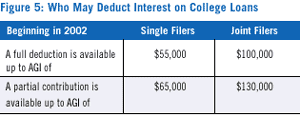| Education Planning |
|
The law expands existing solutions for education funding while also creating a new (but temporary) college tuition deduction.
Bigger Education Savings Accounts Education Savings Accounts (previously known as Education IRAs and recently renamed Coverdell Education Savings Accounts) may be established for a child under age 18 by contributing after-tax money. Withdrawals may be taken tax free for qualifying expenses. Through 2001, the contribution limit was $500 per child. Starting in 2002, a contribution of up to $2,000 per child may be made by joint filers with up to $190,000 of AGI, and for single filers, up to $95,000. (Any contributions to a Coverdell Education Savings Account do not affect ability to contribute to a traditional or Roth IRA.) Individuals or companies will be allowed to contribute, and contributions may be made as late as April 15 of the following year. |
|
Here is a major change: Starting in 2002, tax-free withdrawals may be used to pay for qualifying costs not only at college, but also at any level of education from kindergarten on. Covered expenses include tuition, fees, room, board, books, computer equipment, and uniforms.
Education Savings Accounts (ESAs) will now have the potential to pay for a significant part of college costs, especially when started for young children. For example, an ESA started when a child is born and funded with $2,000 per year through age 17 would hypothetically compound to $72,758 when the child turns 18 (at an assumed 7% investment return).
Qualified Tuition Plans (529 Plans)
Qualified Tuition Plans (Section 529 Plans) are tax-advantaged programs authorized for state and state-sponsored institutions. Contributions to Section 529 plans are made on an after-tax basis for federal tax purposes, and some states allow deductions against state income taxes. Earnings are tax-deferred, and in 2001, distributions are federally taxable.
Under the new law, private colleges will also be able to establish these programs. Beginning in 2002, distributions made from state-sponsored plans will be excluded from federal income. The same benefit will apply to private plans starting in 2004. Tax-free distributions can be taken against a variety of education expenses, including tuition, fees, books, supplies, and the costs of supporting a special-needs student. It's important to note that penalties can apply at both the state and federal levels on withdrawals that are not made for qualified education expenses, and these withdrawals also are fully taxable.
Qualified Tuition Plans will look more like Coverdell Education Savings Accounts in terms of tax advantages. But there are two big differences:
- No income limits apply to Qualified Tuition Plans.
- The limit on amounts that may be contributed to Qualified Tuition Plans is much higher. Although each state has different contribution limits, up to $250,000 in some states may be contributed per account over time.
Student Loan Interest Deduction
Two major changes have been made in favor of parents and students who use college loans:
- The 60-month repayment period limit will be repealed. Starting in 2002, interest may be deducted without regard to the repayment period.
- The income limits on those who may deduct loan interest have been raised, as shown in Figure 5.

The maximum interest that may be deducted in one year remains $2,500.
College Tuition Deduction
From 2002 through 2005, parents below certain income limits will be allowed to deduct part of their "qualified tuition and related expenses" from federal taxable income.

The deduction is not available to married couples filing separate returns. The deduction is scheduled to "sunset" after 2005.
Planning Ideas for Education Costs
Why Pay Taxes? The enhancements to Education Savings Accounts and Qualified Tuition Plans offer parents and grandparents a new opportunity-to pay most or all of college costs with tax-free earnings. Once after-tax money is contributed to these accounts, every dollar, including earnings, can go to pay a dollar's worth of education costs. Now is the time to review education funding alternatives with a financial professional.
Plan for Private School Students: Starting in 2002, distributions from Education Savings Accounts (also known as Coverdell Education Savings Accounts) can be tax-exempt if used to pay education costs all the way down to kindergarten. That makes it more attractive to start these accounts for younger beneficiaries.
Help Children While Planning Estates: There is a way for grandparents to make large lifetime gifts without federal tax consequence, and this law makes it even more attractive. Up to $50,000 may be gifted per person, per child, to a Qualified Tuition Plan under the annual gift tax exclusion, provided no other contributions or gifts are made to or for the same child during the subsequent five-year period. This gift can grow larger through earnings and eventually enjoy tax-free withdrawals for college under the new law. It's a double tax-saving opportunity..